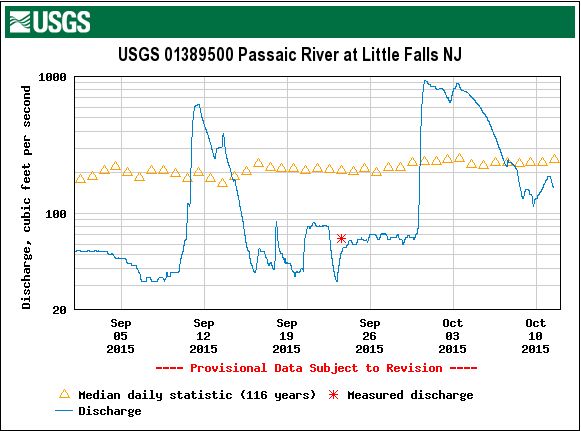Storms Had Little Impact on Drought, Reservoirs, & River Flows
Managing Drought With a Drought Of Management at DEP
Flood of Slogans & Press Releases Mask Mismanagement & Christie’s Policy
The Bergen Record reported today that the rainfall from last week’s nor’easter which caused so much coastal erosion had little impact on the drought in northeast NJ, see this:
Once again, the critical river low flow issues are presented as clear as mud, and buried at the very end of the story:
The reservoir was at 47.1 percent on Friday. But it was supplying about 25 million gallons less per day than it was at the beginning of September.
The commission has been pumping millions of gallons from Passaic River tributaries to meet demand. Even though the DEP in 2013 allowed the commission to pump an extra 17 million gallons a day during peak demand periods, a spokesman said even that may not be enough.
“The river flow is decreasing enough that we may have to stop until another rainfall,” Maer said. “We’re pumping when we can to keep the levels as high as possible.”
As you can see from the USGS hydrograph above, river flow rebounded, but is heading down again.
The rainfall made only a slight dent in reservoir levels, and pumping of river water appears to have been halted again as a result of “minimum passing flow” conditions in DEP permits.
We are glad that the Record is staying with this story, but we still wish they would focus on important drought related issues:
1) Human Health Risks
The lack of rainfall and low flows in the rivers result in lower water quality. That increases human health risks. The critical pollutant of concern is the nitrate level: as river concentration approaches the 10 mg/L (ppm) drinking water standard, the river intakes for water supply must be shut down because there is no treatment for nitrate. However, there are many other risks, ranging from trihalomethanes that result from additional treatment to remove a higher percentage of organic content (algae, et al) from river water; to hundreds of unregulated chemicals discharge by sewage treatment plants (Google Tittel’s award winning soundbite about “Viagara Falls”)
2) Ecological Impacts – Whatever happened to the DEP’s “Eco-Flow Goals” Project?
The negative effects of drought are not limited to threats to the water supply for people. The low flows in the river have adverse impacts on aquatic life – I know next to nothing about the aquatic life in the Passaic basin, but I’m sure there are many scientists, fishermen, and watershed advocates who do. That story needs to be told.
3) Infrastructure – From Leaks to Lack of Adequate Storage to Reliance on rivers
Northeast NJ’s water supply infrastructure is in a precarious situation – by design – due to lack of adequate reservoir storage capacity. Aging infrastructure is another problem – the Record recently reported leakage rates for United Water, but in the context of a request rate increase. The larger infrastructure story needs to be told comprehensively.
4) Water Supply Planning – Where’s the Plan?
Governor Christie’s Office has buried the DEP drafted update of the Water Supply Master Plan for political reasons. As a result, the public and water supply managers lack current data and relevant policy framework to make important management decisions.
- Drought of data – After declaring a drought watch and urging voluntary conservation, DEP has no data on water conservation efforts and is not even asking for that data to be collected.
- Projected population growth and increasing demand will put additional stress on the system and result in more frequent drought conditions.
- Climate change is projected to change rainfall patters, resulting in more frequent large rainfall events and more prolonged dry period. At the same time, NJ’s landscape is increasing developed with impervious surfaces as natural vegetation is destroyed. This has huge implications for water supply, because so much water is lost as runoff from larger storms and there is less groundwater recharge and reservoir storage.
There are many other examples of issues that need to be addressed via the Water Supply Plan update.
5) What ever happened to DEP’s Asset Management initiative?
The highly touted DEP “Asset Management” initiative is dead in the water (no pun!).
Asset management will force DEP, private sector, and local water managers to being to develop a systematic approach to assessing and managing infrastructure.
6) Lack of Funding – The Open Space Diversion
The fact that NJ has a massive water infrastructure upgrade financial deficit has been widely reported.
But there’s been no coverage of the fact that the Open Space ballot approval diverted significant funding from water resource management programs, just when more challenges are emerging that require more costly management efforts, from data collection to scientific expertise.
7) Christie DEP Rollbacks of Land Use and Water Resource Protections
Christie DEP Commissioner Bob Martin himself has openly announced plans to rollback existing land use and water resource regulatory protections.
Just at the point in time when climate change impacts are becoming increasingly visible, the DEP is ignoring those issues – both the need to dramatically reduce emissions and to adapt to projected impacts.
Just when structural drought and basic hydrology are becoming part of everyday experience, DEP is rolling back land use and water resource protections that will exacerbate water quality, flooding, and drought issues.
There are several stories waiting to be written about DEP’s Water Management Deficits.
